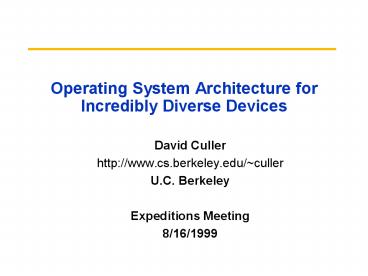Operating System Architecture for Incredibly Diverse Devices - PowerPoint PPT Presentation
1 / 17
Title:
Operating System Architecture for Incredibly Diverse Devices
Description:
massive computing and storage in the infrastructure. active adaptation of form and content 'along ... spagetti part of an application is configuring the flows ... – PowerPoint PPT presentation
Number of Views:75
Avg rating:3.0/5.0
Title: Operating System Architecture for Incredibly Diverse Devices
1
Operating System Architecture for Incredibly
Diverse Devices
- David Culler
- http//www.cs.berkeley.edu/culler
- U.C. Berkeley
- Expeditions Meeting
- 8/16/1999
2
Away from the average Device
3
Convergence at the Extremes
- Powerful Services on Small Devices
- massive computing and storage in the
infrastructure - active adaptation of form and content along the
way - Extremes more alike that either is to the middle
- More specialized in function
- Communication centric design
- wide range of networking options
- Federated System of Many Many Systems
- Hands-off operation, mgmt, development
- High Reliability, Availability
- Scalability
- Power and space limited
- simplicity
- They have to work or die!
4
Body of Work in the Very Large
- Academic metacomputing, computational grid
- Glunix (UCB), Globus(ANL), Legion (UVA), IPG
(NASA), Harness, NetSolve, Snipe (UTK), EMOP,
Apples, Cactus, Meta-Chaos, ... - Commercial
- LSF
5
Dominant thrust Glue over big OS
- Nodes a full OS and Institutional structure
- accounts, authentication, resources, execution,
storage, policy - User constructs a personal virtual machine
spanning numerous, potentially diverse resources - mapping from uniform metasystem mechanisms to
site specific mechanism - naming, authentication, transparent execution,
storage, scheduling - uniform, multiprotocol communication mechanism
- Many nodes in a net, not Unix on Steroids
- mgmt is fundamental problem, but still unadressed
6
And in the small...
- Academic
- microkernels, Exokernel, OSKit, ucLinux, ELKS,
- Commercial
- PalmOS, PSION, GeoWorks, WinCE, Inferno, QNX,
VxWorks, javaos, chorusOS, BeOS, - jini, corba, dcom, ...
- gt tracks the 80386
- when it becomes 1990 PC Unix will run on it
7
Small OS Dominant thrust
- Unix on a diet real time seasoning
- Microkernel finally works on small devices
- ability to remove components (modularity) fault
boundaries more important than performance - legacy applications less dominant
8
Design Issues for Small Device OS
- Managing address spaces
- Thread scheduling
- IP stack
- Windowing System
- Device drivers
- File system
- Applications Programming Interface
- Power management
9
Core Questions
- What are the principles of design for tiny
operating systems? - How are they different from a desktop or server?
- Where should we look for ideas and experience?
- How can operating systems be made radically
simpler? - How should we proceed with the investigation?
10
1st Stab at Principles for Simple OS
- Communication is fundamental
- treated as part of the hardware. No comm is like
no power - you dont bring up the device then configure
comm. - hands off a direct user interface is the
exception not the norm - typical device has a network on one side
sensor/actuators on the other - buttons and display a special case
- all deployment, development, configuration, mgmt,
programming, is through the communication
interface - schedule data movement, not arbitrary threads of
computation - constant self-checking and telemetry
- rely on the infrastructure for hard stuff
11
other places to look for ideas
- Operating systems that are not called operating
systems - eg modern disk controller
- event scheduler handling stream of commands from
network link, controlling complex array of
sensors and actuators, performing sophisticated
calculations to determine what and when
(scheduling and caching) as well as transforming
data on the fly - automatic connection, enumeration, configuration
- but several simplifying assumptions must be
removed
Complex array of Sensors and actuators
Network link - EIDE, SCSI - FCAL, SSA - USB,
1394 - ???
12
OS as little more than FSM
- Primary focus is scheduling discrete chunks of
data movement - not general thread scheduling and unlimited
memory management - there may be a bounded amount of work to xform or
check data - Commands are an event stream merged with
sensor/actuator events - General thread must be compiled to sequence of
bounded atomic transactions - spagetti part of an application is configuring
the flows - steady-state is straight-forward event processing
signaling unusual events - Simplify network-based debug and mgmt
13
Adaptation in Flows
- View data transfers as continuous flows
- plumbing as programming model
- reservoirs provide slack
- trade bandwidth for robustness
- Natural form of adaptation
- ex faster consumer gets more data
- flow equations provide goal, simple error bounds,
and react - performance availability
14
Example streaming output
High water mark gt stop input
low water mark gt start input
- Events associated with particular configuration
of reservoirs and flows drive operation
scheduling - hard to effect through queue management and
priorities of threads
15
Availability gt Performance availability
16
Alternative Comm Location independent Access
to shared storage
- Key Concepts from Parallel Architecture
- hierarchical composition of cache-coherence
protocols consistency models - natural framework for adaptation (pull what you
touch)
17
How to proceed?
- A lot of experience to be gained from the chopped
desktop OS efforts - same time-to-mkt benefit research prototype
- brings many small, interesting devices on line
- bring Universal Computing Lab on-line (IRDA
802.11) - and from meta-OS efforts
- Build simulation environment for bottom-up
development - currently exploring UCLA GloMo simulator
- Develop always-on networking component for
expedition testbed - Deploy for unusual new devices
- smart boulders -gt pebbles -gt dust































